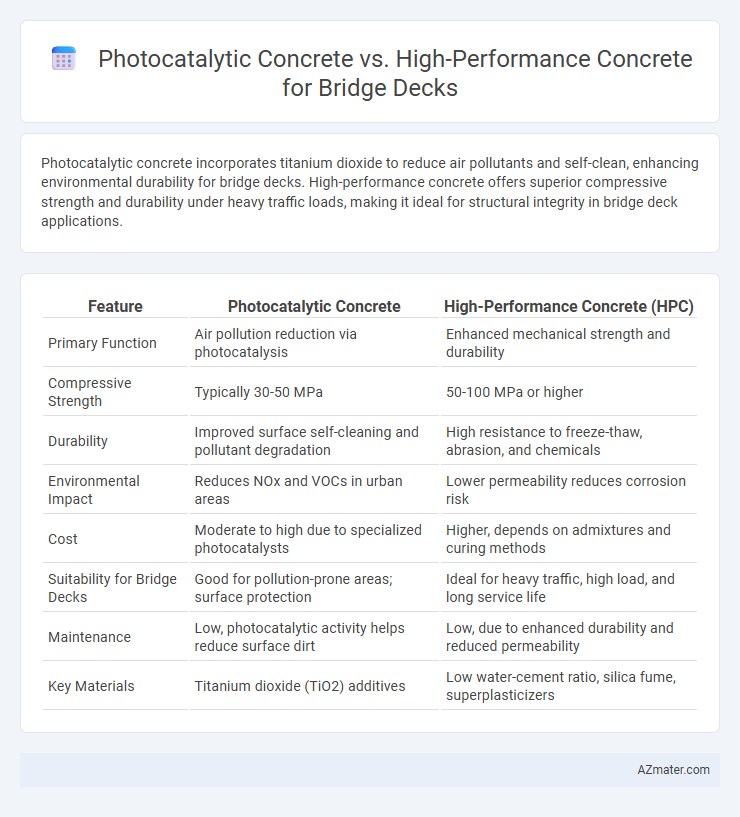Photocatalytic concrete incorporates titanium dioxide to reduce air pollutants and self-clean, enhancing environmental durability for bridge decks. High-performance concrete offers superior compressive strength and durability under heavy traffic loads, making it ideal for structural integrity in bridge deck applications.
Table of Comparison
| Feature | Photocatalytic Concrete | High-Performance Concrete (HPC) |
|---|---|---|
| Primary Function | Air pollution reduction via photocatalysis | Enhanced mechanical strength and durability |
| Compressive Strength | Typically 30-50 MPa | 50-100 MPa or higher |
| Durability | Improved surface self-cleaning and pollutant degradation | High resistance to freeze-thaw, abrasion, and chemicals |
| Environmental Impact | Reduces NOx and VOCs in urban areas | Lower permeability reduces corrosion risk |
| Cost | Moderate to high due to specialized photocatalysts | Higher, depends on admixtures and curing methods |
| Suitability for Bridge Decks | Good for pollution-prone areas; surface protection | Ideal for heavy traffic, high load, and long service life |
| Maintenance | Low, photocatalytic activity helps reduce surface dirt | Low, due to enhanced durability and reduced permeability |
| Key Materials | Titanium dioxide (TiO2) additives | Low water-cement ratio, silica fume, superplasticizers |
Introduction to Bridge Deck Materials
Photocatalytic concrete incorporates titanium dioxide to actively reduce pollutants and improve air quality, making it an innovative choice for environmentally conscious bridge decks. High-performance concrete (HPC) offers enhanced durability, high strength, and reduced permeability, ensuring long-lasting structural integrity under heavy traffic and environmental stress. Both materials address specific challenges in bridge deck construction, with photocatalytic concrete targeting sustainability and HPC focusing on mechanical performance and longevity.
Overview of Photocatalytic Concrete
Photocatalytic concrete incorporates titanium dioxide nanoparticles that activate under UV light to break down pollutants on and around the bridge deck, enhancing air quality and reducing maintenance costs. This innovative material demonstrates self-cleaning properties and improved durability against environmental degradation compared to traditional concrete. While high-performance concrete emphasizes strength and durability through optimized mix designs, photocatalytic concrete offers added environmental benefits crucial for urban bridge applications.
Understanding High-Performance Concrete
High-performance concrete (HPC) used in bridge decks offers superior mechanical properties and durability compared to traditional and photocatalytic concrete, featuring optimized mix designs that enhance strength, toughness, and resistance to environmental degradation. HPC typically incorporates supplementary cementitious materials like silica fume or fly ash, improving its microstructure to reduce permeability and increase resistance to chloride ion penetration, crucial for extending bridge deck service life. This advanced performance makes HPC ideal for infrastructure exposed to heavy traffic loads and aggressive environments, ensuring long-term structural integrity and reduced maintenance costs.
Material Composition and Properties
Photocatalytic concrete incorporates titanium dioxide nanoparticles, enabling self-cleaning and air-purifying properties by catalyzing the breakdown of pollutants on the bridge deck surface. High-performance concrete (HPC) utilizes a mix of low water-cement ratio, supplementary cementitious materials like silica fume, and superplasticizers to achieve superior strength, durability, and chloride resistance essential for harsh bridge environments. Photocatalytic concrete emphasizes environmental benefits, whereas HPC focuses primarily on mechanical performance and longevity under heavy traffic and aggressive weather conditions.
Photocatalytic Activity and Environmental Benefits
Photocatalytic concrete incorporates titanium dioxide nanoparticles that activate under sunlight to break down pollutants, significantly reducing NOx and VOC levels on bridge decks. This self-cleaning and air-purifying property enhances environmental benefits by improving urban air quality and reducing maintenance costs compared to traditional high-performance concrete. High-performance concrete primarily focuses on strength and durability but lacks the photocatalytic activity critical for environmental remediation on bridge surfaces.
Strength and Durability Comparison
Photocatalytic concrete integrates titanium dioxide to enhance self-cleaning and pollution reduction, maintaining comparable compressive strength to high-performance concrete (HPC) typically ranging from 50 to 70 MPa. HPC is engineered with optimized mix designs and admixtures, achieving superior strength often exceeding 80 MPa and exceptional durability against freeze-thaw cycles, chloride penetration, and abrasion crucial for bridge decks. While photocatalytic concrete offers environmental benefits through pollution mitigation, HPC provides enhanced structural performance and longevity, making it more suitable for demanding load and durability conditions on bridge decks.
Maintenance and Longevity
Photocatalytic concrete incorporates titanium dioxide additives that actively break down pollutants and organic materials on the bridge deck surface, reducing maintenance frequency by preventing surface degradation and staining. High-performance concrete (HPC) offers enhanced strength, durability, and resistance to freeze-thaw cycles and chloride ion penetration, significantly extending the structural longevity and minimizing repair costs. Combining photocatalytic properties with HPC formulations can optimize both self-cleaning functions and long-term durability, making it an advanced solution for sustainable bridge deck maintenance.
Cost Considerations and Economic Impact
Photocatalytic concrete incorporates titanium dioxide to reduce air pollution, potentially lowering maintenance costs by preventing surface degradation and reducing environmental damage. High-performance concrete, characterized by enhanced durability and strength, offers long-term savings through extended service life and reduced need for repairs, despite higher initial material costs. Evaluating economic impact involves balancing the photocatalytic benefits in urban pollution mitigation with the superior structural longevity of high-performance concrete for bridge decks.
Real-World Applications and Case Studies
Photocatalytic concrete, embedded with titanium dioxide, actively reduces air pollutants and enhances surface self-cleaning on bridge decks, demonstrated by its successful deployment in urban viaducts such as the Oizumi Bridge in Japan. High-performance concrete (HPC) offers superior mechanical properties and durability, evidenced by its use in the Millau Viaduct, France, where resistance to corrosive environments and load-bearing capacity are critical. Comparative case studies reveal photocatalytic concrete improves environmental impact, while HPC ensures structural longevity, guiding material selection based on specific bridge deck performance requirements.
Future Trends in Bridge Deck Construction
Photocatalytic concrete offers self-cleaning and pollution-reducing properties by incorporating titanium dioxide, enhancing durability and environmental sustainability in bridge decks. High-performance concrete (HPC) provides superior strength, reduced permeability, and improved resistance to freeze-thaw cycles, extending the lifespan of bridge structures under heavy traffic loads. Future trends in bridge deck construction emphasize integrating photocatalytic concrete with HPC to create multifunctional materials that combine structural resilience with environmental benefits.

Infographic: Photocatalytic concrete vs High-performance concrete for Bridge deck
 azmater.com
azmater.com